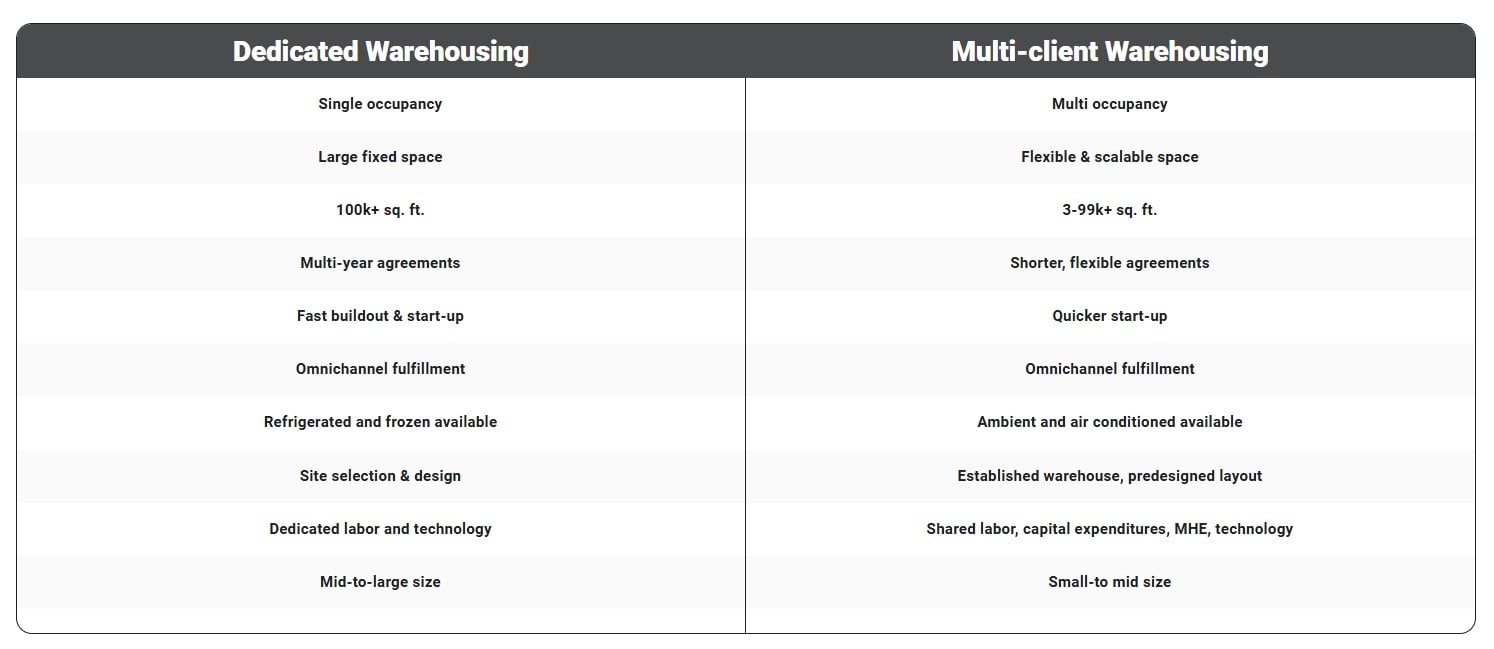Imagine your warehouse is like a big closet—organized, spacious, and not just a giant heap of stuff everywhere. In the world of supply chain and logistics, warehousing is a fundamental realm where goods hang out before they hit the shelves. Recently, companies are giving their warehousing models a serious makeover, and one trend that's stealing the spotlight is multi-client warehousing.
What’s all the buzz about? Simply put, more businesses are discovering that sharing is caring, especially when it comes to warehousing. Let’s dive into this rising star of the distribution process and explore why it might just be your new best friend.
What is Multi-Client Warehousing?
Let's shine the headlights on multi-client warehousing, often referred to as shared or public warehousing. Think of it as the communal living of the warehousing world, where multiple businesses get settled in the same space, sharing resources under the watchful eye of a savvy third-party logistics provider (3PL).
Here’s what makes it appealing for businesses:
- Shared Labor and Equipment: Hire your own team to split the workforce with someone else.
- Scalable Storage Capacity: During busy periods like the holidays, this highly flexible option allows you to expand or shrink your space as needed.
- Value-Added Services: Why settle for just storage when you can enhance your operations? With services like kitting, bulk packing, cross-docking, and order consolidation, you can streamline processes and consolidate costs effortlessly.
- Centralized Management: Leaves the heavy lifting to the pros so you can focus on what you do best.
Multi-Client vs. Dedicated Warehousing: The Showdown
Let’s compare the key differences between multi-client and dedicated warehousing.
Here’s how they stack up:

It’s clear that both options offer several advantages. Deciding between these models really depends on your business size and needs. Multi-client warehousing is ideal for businesses looking to be agile and cost-effective, whereas dedicated warehousing typically works for those wanting customization and enhanced service levels. Ultimately, the right choice should be like a perfectly tailored suit—crafted just for you.
Many companies that use multi-client warehousing enjoy reduced overhead costs and flexible space to adapt to fluctuating demand. According to Logistics Management, businesses leveraging multi-client warehousing can cut warehousing costs by up to 30%, making it an attractive option for retailers with varying inventory needs.
In contrast, dedicated warehousing operates like a private office that’s exclusively designed for one company. With dedicated warehousing, order fulfillment speed could be increased to cater to companies with consistent, high-volume inventory demands.
If you’re not sure what inventory demands could be month-to-month, MCW might be the way to go. If you’ve got specialized needs and have the budget with systems in place to go solo, consider dedicated warehousing.
What are the Benefits of Multi-Client Warehousing?
Let’s take a deeper dive into why businesses should embrace multi-client warehousing:
1. Cost Efficiency: Sharing overhead means slashing costs. Some companies report savings of 15–30% annually, which can be a game-changer for your bottom line.
2. Scalability and Flexibility: Just like swapping out summer clothes for winter gear, you can easily adjust your storage as demand shifts. Perfect for those holiday rushes.
3. Speed to Market: Building or finding a new facility can take up much needed valuable time. MCW speeds up onboarding, letting you hit the ground running.
4. Access to Technology and Expertise: An established 3PL has already done the legwork so you can cover all your bases. User-friendly tech and solutions are built in to make your life easier.
5. Risk Mitigation: Say goodbye to high capital expenditures. Plus, should your business strategy change, it’s much simpler to pivot without hefty commitments.
When is Multi-Client Warehousing the Right Choice?
Adaptability is the name of the game, and it can make or break a business. According to surveys and reports conducted by the National Retail Federation, about 60 - 70% of companies encounter challenges with inventory management. This is where multi-client warehousing comes into play, offering a nimble solution for various types of businesses.
Multi-client warehousing shines for:
- Startups and high-growth companies who are finding their footing
- Seasonal businesses that need flexibility
- Anyone looking to dip their toes into new markets without diving headfirst
Choosing the Right Multi-Client Warehouse Partner
Picking a warehouse partner is like building a Lego set; you want to make sure all the pieces fit.
Here’s what to look for when choosing the right partner:
- Proven experience in multi-client models and knows the ropes
- Transparent pricing structures
- A forward-looking tech setup with real-time tracking capabilities
- KPI reporting to keep your operations on track
The Role of Multi-Client Warehousing in E-Commerce
Warehousing and e-commerce go together like peanut butter and jelly. And with the necessary ingredients in place, everything can be just as smooth and satisfying (minus any risk of allergies). Logistics Management reports that over 45% of shippers invest in shared warehousing to enhance their logistics capabilities and meet customers' demands in the online space.
Industries like fashion and electronics exemplify the benefits of this approach. For instance, an online clothing retailer facing seasonal demand spikes can leverage a multi-client warehouse to access extra storage without the burden of a dedicated facility. Similarly, electronics companies benefit from the flexibility to adapt logistics strategies amidst rapid product turnover, ensuring the timely availability of new items.
This model also supports e-commerce beauty retailers as brands share space with established beauty products, allowing access to existing shipping infrastructure. As e-commerce grows, the synergy between multi-client warehousing and online retail demonstrates how collaboration can fuel efficiency and success in today's interconnected market.
Do CPG Companies Use Multi-Client Warehousing and Why?
Consumer packaged goods (CPG) companies are increasingly turning to multi-client warehousing solutions to optimize their operations. This approach streamlines resource management, reduces costs, and enhances service delivery across retailers and wholesalers.
Here are a few reasons why CPG brands use multi-client warehousing:
- Efficiency Improvement: Enhances the management of diverse CPG inventory—such as food, beverages, household goods, and personal care items—across multiple retail channels and distribution points, ensuring products are always available to meet consumer demand.
- Cost Reduction: Minimizes storage and operational costs by consolidating inventory resources, allowing brands to allocate funds more effectively.
- Data Accessibility: Provides real-time insights into inventory levels and usage patterns, enabling supply chain managers to make informed decisions about purchasing and stock management.
- Enhanced Collaboration: Facilitates seamless communication and cooperation among different vendors and suppliers, ensuring that customer satisfaction is not hindered by supply chain issues.
- Scalability: Easily adapts to growing needs, such as expanding product lines or responding to seasonal demands, without requiring significant infrastructure changes.
- Compliance Support: Helps maintain regulatory compliance and industry standards by ensuring that all products are stored and handled according to regulations, reducing the risk of violations.
Case Studies
Ryder’s multi-client warehousing model has helped numerous consumer packaged goods (CPG) brands scale, adapt, and meet market demands with speed and efficiency. Here are three examples that showcase how Ryder’s flexible, scalable approach delivers measurable value:
Case Study 1: Long-Term Growth Through Scalable Storage
Since 2009, a leading producer of organic snack products has partnered with Ryder. Over time, the brand’s inventory stored within Ryder facilities has grown 20x, a testament to the scalability of the multi-client model. With Ryder, the brand benefits from:
- Dedicated organic product handling
- Seamless Amazon fulfillment integration
- Specialized services like repacking and labeling
Case Study 2: From Startup Space to Dedicated Facility
A well-known manufacturer of frozen treats and dessert mixes began with just 5,000 square feet of space in Ryder’s multi-client warehouse. As the brand expanded, Ryder provided flexible growth paths—first to 95,000 square feet, and eventually into a fully dedicated 300,000-square-foot facility. This smooth transition illustrates how multi-client warehousing can support brands at every growth stage.
Case Study 3: Adapting to Seasonal Surges and Special Projects
A fast-growing natural food brand joined Ryder’s multi-client network in 2019. Since then, its storage requirements have tripled, supported by Ryder’s ability to flex space and services as needed. In addition to day-to-day fulfillment (including Amazon), the brand relies on Ryder for:
- Special project support, including kitting and unboxing
- Heat wrapping and repackaging
- Agile response to promotional and seasonal spikes
Final Thoughts on Multi-Client Warehousing
The future looks bright for multi-client warehousing—especially with e-commerce continuing to flourish and evolving market dynamics creating opportunities for those willing to adapt.
In a world where port-to-door supply chain needs are constantly evolving, multi-client warehousing could be your secret weapon for staying ahead of the curve. It’s time to say hello to smarter storage solutions.
Feeling inspired to rethink your warehousing strategy? Dive into the world of multi-client warehousing and see how it can transform your operations for the better. The experts at Ryder are here to help by offering free consultations or a thorough warehousing assessment.





